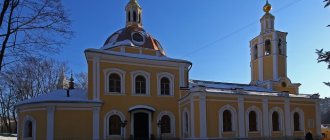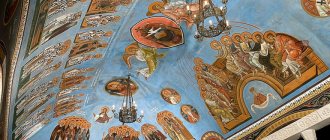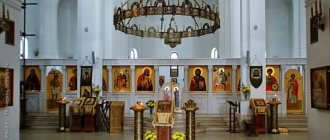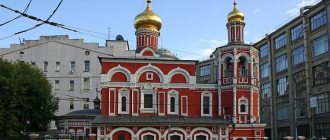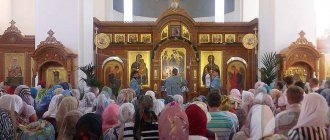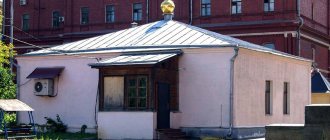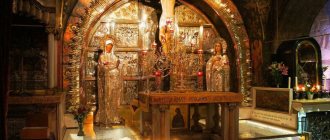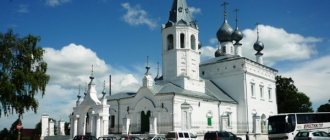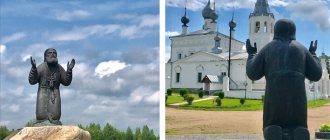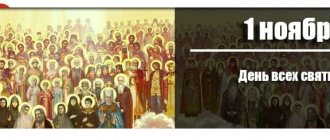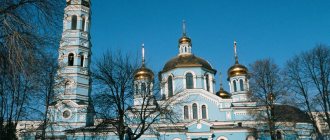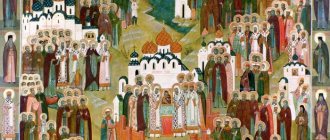Why was Krasnoe Selo, which was once scattered along the city walls of Moscow, called "Red"? No, rivers of blood did not flow here (although what corner of our Motherland can be said so categorically?), houses were not painted scarlet, and Semyon Mikhailovich Budyonny did not wave his sword. It’s just that since ancient times these places were unusually picturesque, beautiful, “red”, which local residents could only notice in the name of the settlement. “What beauty, sweetness!” - Ivan Vasilyevich would have exclaimed, having passed Krasnoe Selo, - but it is quite possible that there was, because the first mention of the settlement appeared a hundred years before the birth of the formidable king. In the 18th century, Krasnoe Selo found itself within the city limits, and in the 19th century, the Alekseevsky convent was moved here, which henceforth became, accordingly, Novoalekseevsky, on the territory of which the Church of All Saints was soon built. - one of the most unusual churches in Moscow. But first of all!
How to get to the temple?
The easiest way to visit Krasnoye Selo in Moscow and the Church of All Saints itself is to use the metro.
- The metro station closest to the temple is Krasnoselskaya (as you can see, toponymy in this area is very diverse, the main thing is not to get confused).
- From the metro, turn left along Krasnoprudnaya Street, go under the Rusakovsky overpass, turn left again and walk in the given direction until you see a red brick fence (red again!). Voila, you are almost there: to your right is the entrance to the Alekseevsky Monastery, to which the Church of All Saints belongs.
Holy Bogolyubsky Alexievsky Monastery of Vladimir Diocesan monasteries of the Russian Orthodox Church
In 1238 the monastery was burned by the Tatar-Mongols. The monastery was reopened in 1362 by the friend and comrade-in-arms of Sergius of Radonezh, Alexy, who was the rector of this monastery, and later the Metropolitan of Kyiv and All Rus'.
In 1362, upon arrival at the monastery, Metropolitan Alexy of Kiev appointed his disciple Pachomius of Nerekhta as abbot.
Saint Alexy gave the order to build a wooden church in honor of the holy Equal-to-the-Apostles Tsar Constantine and his mother Queen Helena. Initially, the cathedral Church of Tsar Constantine was built at the monastery in 1362, which in the decree of the Synod of 1752 was already listed as a cathedral church in the name of the holy blessed kings Constantine and Helen. For several years Pachomius ruled the monastery, organized the order of life, edifying the brethren in word and deed. Having restored the monastic order, Pachomius retired to the Kostroma lands, where he founded the Trinity Monastery in the village. Sypanovo, where he rested in peace on March 21, 1384 and was buried there.
In 1389, Grand Duke Vasily Dmitrievich gave an inviolable charter to the Kostyantinovsky Metropolitan Monastery and the village, and in 1391, Metropolitan Cyprian, “based on the petition of the monastery orphans,” gave his house monastery a statutory charter defining the relationship of the monastic people to the monastery. Their duties according to this charter should be as follows: “by the great people from the monastery villages, decorate the church, build the monastery and courtyard, set up mansions, set up abbots’ lots and gates, and sow and reap and bring, mow hay in tithes and bring into the courtyard, to beat the spring and winter, to weave gardens, to go to the seine, to pond the ponds, to give water to the beavers in the autumn, and to clog the springs, and on Great Day and Peter’s Day they come to the abbot, whatever is in their hands; and as a pedestrian from the villages, for the holiday, grind rye and bake bread, grind malt, brew beer, grind rye for seed; and the abbot gives flax to the village, and they spin the nets and dress the nets; All people from the villages give yalovitsa for the holiday; and to which village the abbot will come to the fraternity and the hay will be given by the abbot’s horse for harvesting oats.”
In 1478, Metropolitan Gerontius gave the Constantine-Eleninsky Monastery a non-judgmental letter, according to which his (the Metropolitan’s) governors and tiuns “do not enter or send anything to the archimandrite of that monastery, nor judge him, nor his monks, nor monks, nor servants monastic, nor Christian, but the archimandrite himself is in charge of judging; The archimandrite is judged by the metropolitan himself.”
In 1504, Grand Duke John III Vasilyevich confirmed to the “Konstantino-Oleninsky” monastery and its villages a non-judgmental charter, according to which the princely governors and volosts of the abbot, priest and elders of the monastery and monastery people “do not judge anything except murder and robbery.” At this time, according to the instructions of this charter, the following villages belonged to the monastery: Suromna, Konstantinovskoye (Dobroe village) and the village of Penki.
At the beginning of the 17th century. The Constantine-Eleninsky Monastery did not escape the Lithuanian devastation, like the Bogolyubov Monastery.
In 1694, in addition to the village of Dobrogo, this monastery owned the village of Suromna, and “in Volodymer, inside the city opposite the Rozhdestven Monastery, there was a monastery siege courtyard and a monastery mill on the Sungir River.”
In 1715, Archimandrite Dionysius. In 1721, due to the dilapidation of the buildings and the scarcity of means of maintenance, the Constantine-Eleninsky Monastery was abolished and assigned to the Bogolyubov Monastery, but in 1727, at the request of the brethren, it was again restored and left on its previous basis under the control of the abbots.
According to the states of 1764, the monastery was made second-class with an archimandrite as abbot.
Archimandrite Abraham of the Constantine-Elenin Monastery began the construction of the five-domed stone Church of Constantine and Helena.
In 1775, according to the decree of the Holy Synod, due to the dilapidation of the buildings, the Konstantin-Eleninsky Monastery was finally abolished and its brethren were transferred to the Nikolo-Volosovsky Monastery, with the abbot, brethren and church utensils, which is why it was sometimes called the Tsarekonstantinovsky Nikolaevsky Monastery.
The monastery was closed, the temple was transferred to the community of the village of Dobroye.
At the beginning of the 19th century. The Church of Constantine and Helena was completed, expanded in 1865, and two chapels were built in the refectory. There were three thrones: in the cold one in the name of Equal-to-the-Apostles Tsar Constantine and his mother Helen, in the warm aisles in the name of Nicholas the Wonderworker and in the name of the saints. Alexy, Metropolitan of Moscow.
In 1885, at the expense of the peasant M.D. Kulikov, a brick bell tower was built next to the church.
In the church there was an image of the Equal-to-the-Apostles Tsar Constantine and his mother Queen Helena, from an ancient letter. Since 1771, this icon was taken to Vladimir every year from May 21 to June 16 and carried home along with the icon of the Bogolyubskaya Mother of God.
The temple operated until the arrest in 1938 of Archimandrite Joseph (Khrisanfov), who served there.
Through the efforts of the residents of the village of Dobroye, the temple retained its splendor until 1960. Then, by order of the local authorities, everything was broken, taken away, and partially burned.
In 1994, the temple was returned to the Russian Orthodox Church.
In January 2003, the Holy Bogolyubovsky Monastery was transferred to the premises of the former Constantine-Eleninsky parish in the city of Vladimir.
Schedule of services of the Church of All Saints in Krasnoe Selo
Hours of worship are regularly posted on stands at the entrance to the monastery, in the vestibule of the church itself and on the official website, so if you need clarification, consult one of these sources of information. In general, the procedure for providing services is as follows:
- Matins and Divine Liturgy are celebrated from Monday to Friday at 6:40, Vespers at 16:40;
- on Saturdays from 8:00 - Memorial service, from 8:30 - Divine Liturgy, from 17:00 - All-night vigil;
- Sunday from 8:00 - Prayer service, from 8:30 - Divine Liturgy, until 16:00 - Vespers and Prayer service, as well as an akathist before the icon of the Mother of God "Queen".
- On the eve of the great holidays of the twelve years, the All-Night Vigil is celebrated.
Monastery today
Since 2013, the Alekseevskaya Convent has been an active convent. In addition, the main monastery church serves as the Patriarchal Metochion. Services are held at All Saints Church. Services begin at 7.00 and 18.00 on weekdays, and at 9.00 and 17.00 on Sundays.
There is a private school at the monastery. Here children study regular general education subjects, attend classes in the Church Slavonic language, the fundamentals of the Orthodox faith and church singing, and also go on pilgrimage trips.
Gate of the Walk of Fame Memorial Complex
Since 2012, the monastery museum has been opened. It displays materials telling about the history of the monastery, old books, documents and personal belongings of former nuns. A separate section is devoted to the life of Abbess Antonia (Troilina), thanks to whom the monastery flourished and fell apart in the 19th century.
Attractions and shrines of the temple
- The appearance of the temple combines elements characteristic of traditional Russian architecture and romantic motifs. The three-domed bell tower, adjacent to the temple and giving it a shape reminiscent of a ship, is unique in itself.
- The iconostasis of the temple is made of beautiful white marble in the Russian-Byzantine style. The paintings of the vault and frescoes of the masters of the Trinity-Sergius Lavra in a style imitating Byzantine are surprisingly consonant.
- The temple housed the most prestigious necropolis of the Novoalekseevsky Monastery, where many outstanding figures found their final refuge: the poet A.M. Zhemchuzhnikov, physicist P.N. Lebedev, philanthropist and faithful friend of P.I. Stanislavsky and many others. Unfortunately, the necropolis has not survived to this day.
- The temple is famous for its shrines: a copy of the icon of the Mother of God “Queen” and particles of the relics of Philaret of Moscow, considered a saint, the martyr Tatiana, who suffered for her faith, and Seraphim of Sarov, one of the most revered adherents of the Orthodox Church.
Icon of the Mother of God Tsaritsyna
relics of Philaret of Moscow
Novo-Alekseevsky Convent
The history of the Church of All Saints is inseparable from the history of the Alekseevsky Monastery, created around 1360 in Ostozhye and moved in the mid-16th century to the White City. Due to the fact that it was decided to build the Cathedral of Christ the Savior in the place where the Alekseevsky Monastery was located, the monastery was moved to Krasnoe Selo.
In the mid-20s of the twentieth century, due to the abolition of the Alekseevsky Monastery, the Church of All Saints was closed. In 1990, the Church of All Saints was returned to believers. The consecration of the temple took place on Lazarus Saturday in 1991. The main attraction of the temple is the miraculous image of the Mother of God “The All-Tsarina”.
The foundation stone of the Church of All Saints of the Alekseevsky Convent took place on August 23, 1887. After 4 years, the temple was built according to the design of architect A.A. Nikiforov in national-romantic forms using motifs of Russian architecture of the 16th-17th centuries. The building is made of red brick with elements of white stone.
The single-domed, two-story, three-apse temple with the adjacent single-tier “three-domed” bell tower has the shape of a ship. In the upper tier of the passage to the bell tower, church choirs and cells were built.
The central altar of the temple is dedicated to All Saints, and the right side chapel is in honor of the miraculous image of the Kazan Icon of the Mother of God.
The Church of All Saints had a unique iconostasis, designed by architect D.N. Chichagova made of white carved marble in the Russian-Byzantine style. The vaults and under-dome space were painted in the Byzantine romantic style by icon painters of the Trinity-Sergius Lavra. They, along with the monastery icon painters, painted the icons and frescoes that once adorned the Church of All Saints.
During the years of the monastery’s existence, in the lower tier of the temple there was a tomb for persons of clergy and monastic rank, as well as monastic patrons (at present, the chapel in honor of the Kazan Icon of the Mother of God has been moved to the lower temple, where the tomb was previously located). Into a single architectural complex created by architect A.A. Nikiforov, in addition to the temple, there were two paired two-story monastery buildings, connected to the temple by a fence.
In the mid-20s of the 20th century, due to the closure of the monastery, the Church of All Saints ceased to function. The buildings were given over for administrative and economic purposes, which caused colossal damage to the entire artistic and architectural temple ensemble. The destruction of the monastery cemetery was an act of blatant vandalism.
From the 1960s until 1989, the archives of the zemstvo government were kept in the building of the closed church; Part of the territory was occupied by a branch of the Moscow umbrella factory. The crosses on the dome and bell tower were broken; only the sheathing remained of their covering.
By 1990, the Church of All Saints was returned to believers. The consecration of the temple was postponed several times until it finally took place on Lazarus Saturday in 1991. It is noteworthy that this day coincided with the celebration of the memory of St. Alexy, the man of God, the heavenly patron of the monastery. On July 12, 1991, the temple solemnly celebrated its 100th anniversary.
Source: https://sobory.ru/article/?object=03605
Photo of the Church of All Saints in Krasnoe Selo
Krasnoselsky Church of All Saints is “beautiful” at any time of the year.
The parishioners are proud of their church and especially the unusual “three-domed” bell tower.”
This ship takes its parishioners to a bright future!
